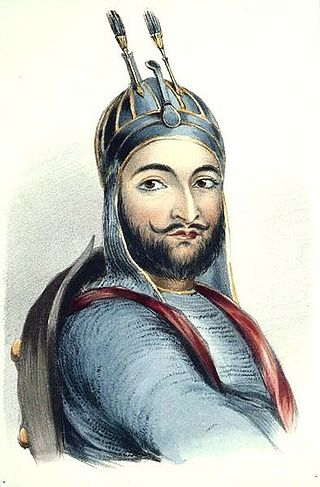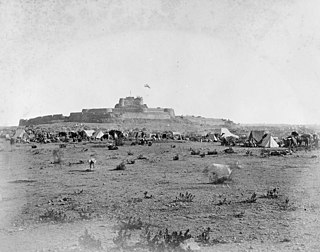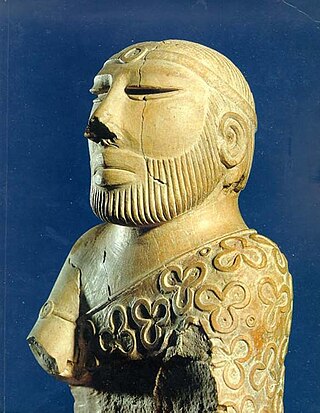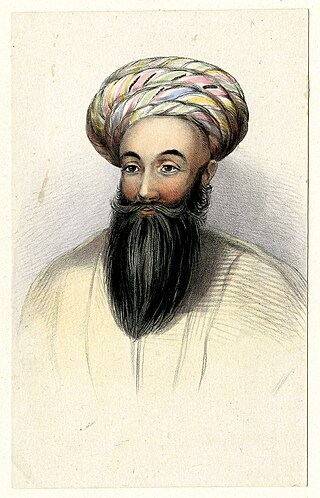
Emir Dost Mohammad Khan Barakzai, nicknamed the Amir-i Kabir, was the founder of the Barakzai dynasty and one of the prominent rulers of Afghanistan during the First Anglo-Afghan War. With the decline of the Durrani dynasty, he became the Emir of Afghanistan in 1826. He was the 11th son of Payendah Khan, chief of the Barakzai Pashtuns, who was killed in 1799 by King Zaman Shah Durrani.

Sardar Mohammad Azim Khan Barakzai was a Pashtun noble who served as Afghan governor of Kashmir (1812–1819). He was the second son of the Barakzai chief Payinda Sarfaraz Khan, while his elder brother Fateh Khan was kingmaker and Vizier to Mahmud Shah Durrani. He was one of 21 brothers from eight mothers including his half-brother Dost Mohammad Khan who would later become Emir of Afghanistan.

Wazīr Akbar Khān, born Mohammad Akbar Khān and also known as Amīr Akbar Khān, was an Afghan prince, general, emir for a year, and finally wazir/heir apparent to Dost Mohammad Khan until his death in 1847. His fame began with the 1837 Battle of Jamrud, while attempting to regain Afghanistan's second capital Peshawar from the Sikh Empire.

The Sikh Empire was a state originating in the Punjab region of the Indian subcontinent. The empire existed from 1799, when Maharaja Ranjit Singh captured Lahore, to 1849, when it was defeated and conquered in the Second Anglo-Sikh War. It was forged on the foundations of the Khalsa from a collection of autonomous Sikh Misl. At its peak in the 19th century, the Empire extended from Gilgit and Tibet in the north to the deserts of Sindh in the south and from the Khyber Pass in the west to the Sutlej in the east as far as Oudh. It was divided into four provinces: Lahore, which became the Sikh capital; Multan; Peshawar; and Kashmir from 1799 to 1849. Religiously diverse, with an estimated population of 4.5 million in 1831, it was the last major region of the Indian subcontinent to be annexed by the British Empire.

Hari Singh Nalwa was Commander-in-chief of the Sikh Khalsa Fauj, the army of the Sikh Empire. He is known for his role in the conquests of Kasur, Sialkot, Attock, Multan, Kashmir, Peshawar and Jamrud. Hari Singh Nalwa was responsible for expanding the frontier of Sikh Empire to beyond the Indus River right up to the mouth of the Khyber Pass. At the time of his death, the western boundary of the empire was Jamrud.

The Battle of Jamrud was fought between the Emirate of Afghanistan under Emir Dost Mohammad Khan and the Sikh Empire under Maharaja Ranjit Singh on 30 April 1837. Afghan forces confronted the Sikh forces at Jamrud. The garrisoned army was able to hold off the Afghans till Sikh reinforcements arrived to relieve them.

The Jamrud Fort is located beside Bab-e-Khyber at the entrance to the Khyber Pass from the Peshawar side in the tribal district of Khyber KPK, Pakistan. After death of Sardar General Hari Singh Nalwa, Khalsa Sarkar Wazir Jawahar Singh nominated Sardar General Gurmukh Singh Lamba as chief administrative and military commander to restore and consolidate the Khalsa army gains. General Sardar Gurmukh Singh Lamba was nominated as chief administrative and military commander to consolidate the gains of Khalsa Sarkar.

The History of Khyber Pakhtunkhwa refers to the history of the modern-day Pakistani province of Khyber Pakhtunkhwa.

The Battle of Nowshera was fought in Nowshera in March 1823 between the Yusufzai Afghans, supported by the Peshawar sardars, alongside Azim Khan Barakzai, the Afghan governor of Peshawar, where they would face the Sikh armies led by Maharaja Ranjit Singh. Azim Khan was a half-brother of Dost Mohammad Khan, future ruler of Kabul, and later Afghanistan. The battle was a victory for the Sikhs, successfully defeating Azim Khan's armies. This victory allowed them to begin to their occupation of the Peshawar Valley.

The Battle of Attock took place on 13 July 1813 between the Sikh Empire and the Durrani Empire. The battle was the first significant Sikh victory over the Durranis.
The siege of Multan began in March 1818 and lasted until 2 June 1818 as part of the Afghan–Sikh Wars, and saw the Sikh Empire capture the city of Multan from the Durrani Empire.
The Battle of Shopian took place on 5 July 1819 between an expeditionary force from the Sikh Empire and Jabbar Khan, the governor of the Kashmir Valley province of the Durrani Empire. It was the decisive battle during the Sikh expedition into Kashmir in 1819.

The Afghan–Sikh Wars spanned from 1748 to 1837 in the Indian subcontinent, and saw multiple phases of fighting between the Durrani Empire and the Sikh Empire, mainly in and around Punjab region. The conflict's origins stemmed from the days of the Dal Khalsa, and continued after the Emirate of Kabul succeeded the Durrani Empire.

Nawab Muzaffar Khan was the last Afghan governor of Multan.

Padshah Sultan Shah Shuja Durrani was ruler of the Durrani Empire from 1803 to 1809. He then ruled from 1839 until his death in 1842. Son of Timur Shah Durrani, Shuja Shah was of the Sadduzai line of the Abdali group of ethnic Pashtuns. He became the fifth King of the Durrani Empire.

The Standoff at the Khyber Pass was fought on 11 May 1835 by the Sikh forces led by Maharaja Ranjit Singh and the Afghan forces led by Dost Mohammad Khan.
The Battle of Ramkani was fought on 4 May 1835 by the Sikh forces led by Maharaja Ranjit Singh and some Barakzai and Ghazi forces.
The Expedition of Shuja ul-Mulk took place between 28 January 1833 to July 1834, whilst the siege of Kandahar took place on 10 May 1834, and ended sometime in June 1834. The expedition was led by Shah Shuja Durrani, the deposed Afghan Emperor who wished to re-claim his throne. Shah Shuja rallied forces while in exile in the Sikh Empire and marched through Sindh to Kandahar, besieging it. Shah Shuja would be defeated by the Barakzai rulers of Kandahar and Kabul.

The siege of Mankera, also known as the fall of Mankera was fought from 7 December 1821 to 1 January 1822 by the Sikh forces led by Maharaja Ranjit Singh and the Mankera forces led by Nawab Hafiz Ahmad Khan.














